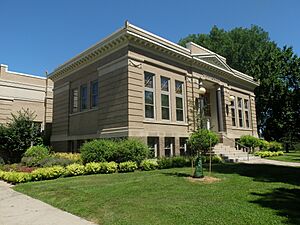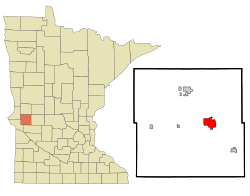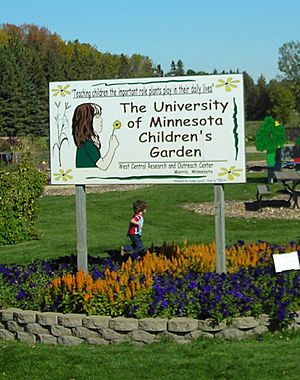Morris, Minnesota facts for kids
Quick facts for kids
Morris
|
|
|---|---|
| City of Morris | |

Morris Carnegie Library, now Stevens County Historical Society Museum
|
|
| Nickname(s):
Motown
|
|
| Motto(s):
"It starts here.", "There's More in Morris!"
|
|

|
|
| Country | United States |
| State | Minnesota |
| County | Stevens |
| Founded | 1871 |
| Founded by | Charles F. Morris |
| Government | |
| • Type | Weak mayor–council |
| Area | |
| • Total | 4.90 sq mi (12.70 km2) |
| • Land | 4.70 sq mi (12.17 km2) |
| • Water | 0.20 sq mi (0.52 km2) |
| Elevation | 1,148 ft (350 m) |
| Population
(2020)
|
|
| • Total | 5,105 |
| • Estimate
(2021)
|
5,206 |
| • Density | 1,086.40/sq mi (419.46/km2) |
| Time zone | UTC-6 (CST) |
| • Summer (DST) | UTC-5 (CDT) |
| ZIP code |
56267
|
| Area code(s) | 320 |
| FIPS code | 27-44242 |
| GNIS feature ID | 2395408 |
Morris is a city in Minnesota, United States. It is the main city in Stevens County. In 2020, about 5,105 people lived there.
Morris is surrounded by rich farmland. Because of this, businesses related to farming are very important to the local economy. One of the biggest dairy farms in Minnesota, Riverview LLP, is based here. Other major businesses include beef and pig farms, factories, schools, and hospitals.
The city is also home to the University of Minnesota Morris (UMM). This college opened in 1960. It is known as a top public liberal arts college.
Contents
History of Morris
Morris was planned out in 1869. It was named after Charles F. Morris, a railroad engineer. The city officially became a village in 1878 and a city in 1902.
Early Schools and Education
In the late 1800s, a boarding school for Native American children was set up in Morris. It was run by the Sisters of Mercy. The goal was to teach students skills for jobs. Later, the government took over the school.
In the early 1900s, the school became the West Central School of Agriculture (WCSA). It taught farming skills. In 1909, this agricultural school became part of the University of Minnesota.
University of Minnesota Morris
When the state decided to close agricultural schools, local people worked hard to save the campus. They convinced the state to open a public college there. In 1960, the University of Minnesota Morris opened. It offers a wide range of subjects for students to study.
Historic Buildings and Earthquakes
Morris has several buildings that are important to its history. These include the Lewis H. Stanton House and the Morris Carnegie Library. They are listed on the National Register of Historic Places.
Morris has also experienced a few earthquakes. In 1975, the biggest earthquake in Minnesota in the 20th century happened here. Another smaller earthquake shook the town in 1993.
Geography and Climate
Morris covers about 4.9 square miles. Most of this area is land, with a small part being water. Lake Crystal is in the southwest part of the city. The Pomme de Terre River flows through the eastern side. Major roads like U.S. Highway 59 pass through Morris.
Morris Weather
Morris has a climate with warm summers. The coldest temperature ever recorded was -41 degrees Fahrenheit in 1936. The hottest was 109 degrees Fahrenheit in 1940.
| Climate data for Morris, Minnesota (West Central Research and Outreach Center), 1991–2020 normals, extremes 1886–present | |||||||||||||
|---|---|---|---|---|---|---|---|---|---|---|---|---|---|
| Month | Jan | Feb | Mar | Apr | May | Jun | Jul | Aug | Sep | Oct | Nov | Dec | Year |
| Record high °F (°C) | 60 (16) |
60 (16) |
83 (28) |
98 (37) |
106 (41) |
104 (40) |
109 (43) |
104 (40) |
106 (41) |
93 (34) |
80 (27) |
69 (21) |
109 (43) |
| Mean maximum °F (°C) | 40.6 (4.8) |
43.5 (6.4) |
59.3 (15.2) |
77.4 (25.2) |
89.0 (31.7) |
92.1 (33.4) |
91.7 (33.2) |
89.9 (32.2) |
87.5 (30.8) |
81.8 (27.7) |
61.7 (16.5) |
44.4 (6.9) |
94.9 (34.9) |
| Mean daily maximum °F (°C) | 19.2 (−7.1) |
23.5 (−4.7) |
36.4 (2.4) |
52.9 (11.6) |
67.5 (19.7) |
77.1 (25.1) |
80.7 (27.1) |
78.9 (26.1) |
71.9 (22.2) |
56.5 (13.6) |
39.0 (3.9) |
25.0 (−3.9) |
52.4 (11.3) |
| Daily mean °F (°C) | 9.8 (−12.3) |
13.8 (−10.1) |
27.3 (−2.6) |
42.4 (5.8) |
56.3 (13.5) |
66.8 (19.3) |
70.3 (21.3) |
67.9 (19.9) |
59.9 (15.5) |
45.5 (7.5) |
30.0 (−1.1) |
16.6 (−8.6) |
42.2 (5.7) |
| Mean daily minimum °F (°C) | 0.5 (−17.5) |
4.1 (−15.5) |
18.2 (−7.7) |
31.9 (−0.1) |
45.2 (7.3) |
56.4 (13.6) |
59.9 (15.5) |
56.9 (13.8) |
47.9 (8.8) |
34.6 (1.4) |
21.0 (−6.1) |
8.1 (−13.3) |
32.1 (0.0) |
| Mean minimum °F (°C) | −20.8 (−29.3) |
−16.7 (−27.1) |
−5.3 (−20.7) |
18.0 (−7.8) |
31.5 (−0.3) |
44.8 (7.1) |
49.0 (9.4) |
45.3 (7.4) |
32.3 (0.2) |
20.2 (−6.6) |
2.5 (−16.4) |
−14.6 (−25.9) |
−24.2 (−31.2) |
| Record low °F (°C) | −40 (−40) |
−41 (−41) |
−30 (−34) |
−2 (−19) |
18 (−8) |
27 (−3) |
38 (3) |
31 (−1) |
20 (−7) |
1 (−17) |
−27 (−33) |
−34 (−37) |
−41 (−41) |
| Average precipitation inches (mm) | 0.72 (18) |
0.74 (19) |
1.20 (30) |
2.24 (57) |
3.10 (79) |
4.38 (111) |
4.25 (108) |
3.46 (88) |
2.68 (68) |
2.44 (62) |
0.99 (25) |
0.75 (19) |
26.95 (684) |
| Average snowfall inches (cm) | 9.1 (23) |
9.0 (23) |
6.9 (18) |
4.5 (11) |
0.0 (0.0) |
0.0 (0.0) |
0.0 (0.0) |
0.0 (0.0) |
0.0 (0.0) |
1.0 (2.5) |
5.2 (13) |
8.9 (23) |
44.6 (113.5) |
| Average extreme snow depth inches (cm) | 10.8 (27) |
12.4 (31) |
11.3 (29) |
3.6 (9.1) |
0.0 (0.0) |
0.0 (0.0) |
0.0 (0.0) |
0.0 (0.0) |
0.0 (0.0) |
0.5 (1.3) |
3.3 (8.4) |
7.3 (19) |
15.1 (38) |
| Average precipitation days (≥ 0.01 in) | 7.4 | 7.1 | 7.6 | 8.4 | 11.1 | 11.7 | 11.0 | 9.6 | 9.0 | 9.0 | 5.7 | 7.7 | 105.3 |
| Average snowy days (≥ 0.1 in) | 8.7 | 7.7 | 4.9 | 2.1 | 0.0 | 0.0 | 0.0 | 0.0 | 0.0 | 0.7 | 4.0 | 8.2 | 36.3 |
| Source 1: NOAA | |||||||||||||
| Source 2: National Weather Service | |||||||||||||
Population of Morris
| Historical population | |||
|---|---|---|---|
| Census | Pop. | %± | |
| 1880 | 743 | — | |
| 1890 | 1,266 | 70.4% | |
| 1900 | 1,934 | 52.8% | |
| 1910 | 1,685 | −12.9% | |
| 1920 | 2,320 | 37.7% | |
| 1930 | 2,474 | 6.6% | |
| 1940 | 3,214 | 29.9% | |
| 1950 | 3,811 | 18.6% | |
| 1960 | 4,199 | 10.2% | |
| 1970 | 5,366 | 27.8% | |
| 1980 | 5,367 | 0.0% | |
| 1990 | 5,613 | 4.6% | |
| 2000 | 5,068 | −9.7% | |
| 2010 | 5,286 | 4.3% | |
| 2020 | 5,105 | −3.4% | |
| 2021 (est.) | 5,206 | −1.5% | |
| U.S. Decennial Census 2020 Census |
|||
In 2010, there were 5,286 people living in Morris. There were 1,986 households. About 23.6% of households had children under 18. Many people lived alone. The average age in the city was 26.5 years old.
Economy and Jobs
Farming-related businesses are a big part of Morris's economy. The local university is also a major employer.
Superior Industries is a large company in Morris. It makes steel conveyors and storage tanks. These are used in industries that handle materials like grains or fuels. The company employs about 800 people.
Higher Education in Morris
The University of Minnesota Morris (UMM) is one of the five campuses of the University of Minnesota system. It started as a public college in 1960. About 1,900 students attend UMM.
Morris is also home to the West Central Research and Outreach Center (WCROC). This center is part of the University of Minnesota. Its staff study topics like farming, soil, animals, and renewable energy.
The WCROC also has beautiful Horticulture Gardens. These gardens are used for research. Many visitors enjoy them each summer.
Local Events
Prairie Pioneer Days
Prairie Pioneer Days is a fun family festival held every July. It celebrates the history of people settling in the area. The festival includes a parade, fireworks, and many food and craft vendors. It also honors the contributions of Native American cultures.
Stevens County Fair
The Stevens County Fair happens in Morris every August. It is known for its entertainment and 4-H events. People from all around come to see exhibits and enjoy time with friends and family.
Media and News
Morris has four radio stations. These include KMRS AM 1230 and KKOK FM 95.7. The University of Minnesota Morris also operates a station, KUMM FM 89.7.
The local newspaper is the Stevens County Times. It publishes on Saturdays and has been around since 1882.
Transportation
The city has its own airport, the Morris Municipal Airport. In the past, Morris also had passenger train service until 1979.
Notable People from Morris
- Gustav A. Anderson (1893–1983), a Minnesota state politician and farmer.
- Dick Grace (1898–1965), a Hollywood stunt pilot.
- Jim Hall, known for creating FreeDOS.
- Mike Morley, a former professional golfer.
- PZ Myers, a biologist and blogger.
- Trina Radke, an Olympic swimmer.
- Aaron Schock, a former U.S. Representative from Illinois.
- Royal A. Stone, a Minnesota Supreme Court justice.
- Brett Winkelman, a former professional basketball player.
- Children 18:3, a Christian punk rock band.
Gallery
See also
 In Spanish: Morris (Minnesota) para niños
In Spanish: Morris (Minnesota) para niños






